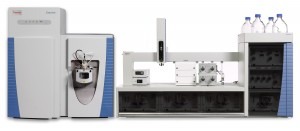
The Chemical and Veterinary Analytical Institute Munsterland-Emscher-Lippe (CVUA-MEL) has standardised on Thermo Scientific LC-MS and GC-MS systems for routine analyses of contaminants in food.
The CVUA-MEL required high-resolution, sensitive instruments that can analyse small-molecular-weight contaminants in samples quickly and accurately and to the lowest limits of detection (LOD).
It selected the Thermo Scientific Exactive benchtop MS coupled with the Transcend TLX system and DFS high resolution GC-MS systems.
The CVUA-MEL aims to ensure food safety through vigorous scrutiny of potentially hazardous residues and contaminants, in line with current legislation.
The Exactive MS and DFS GC-MS systems are being used by the institute to analyse small-molecular-weight compounds such as dioxins, PCBs, pesticides and veterinary drug residues in food, feed and human samples.
The Exactive LC-MS system offers a resolving power of up to 100,000FHWM, along with the ability to run pre-programmed targeted screening of samples without the need for thorough clean-up when combined with the Thermo Scientific Transcend TLX system.
This benefit is achieved through the Transcend TLX system's capacity to automate online sample preparation, eliminating the manual extraction and cleaning of compounds.
The Exactive LC-MS is also designed to provide efficient, automated screening of urine samples taken from farms, detecting illegal drugs administered to animals and ensuring that withdrawal periods are being upheld by farmers in accordance with EU legislation.
According to the company, the instrument delivers the analytical performance of a much larger instrument while taking up minimal space in the laboratory.
Since its implementation, the Thermo Scientific DFS high-resolution GC-MS has significantly improved the analysis of dioxins, PCBs and brominated flame retardants at the CVUA-MEL, its staff claim.
The versatile nature of the system, with its optional two GCs for different column separations, provides the ability to simultaneously run two separate unattended batches of samples at different settings, increasing screening speed, overall throughput and full method versatility.




